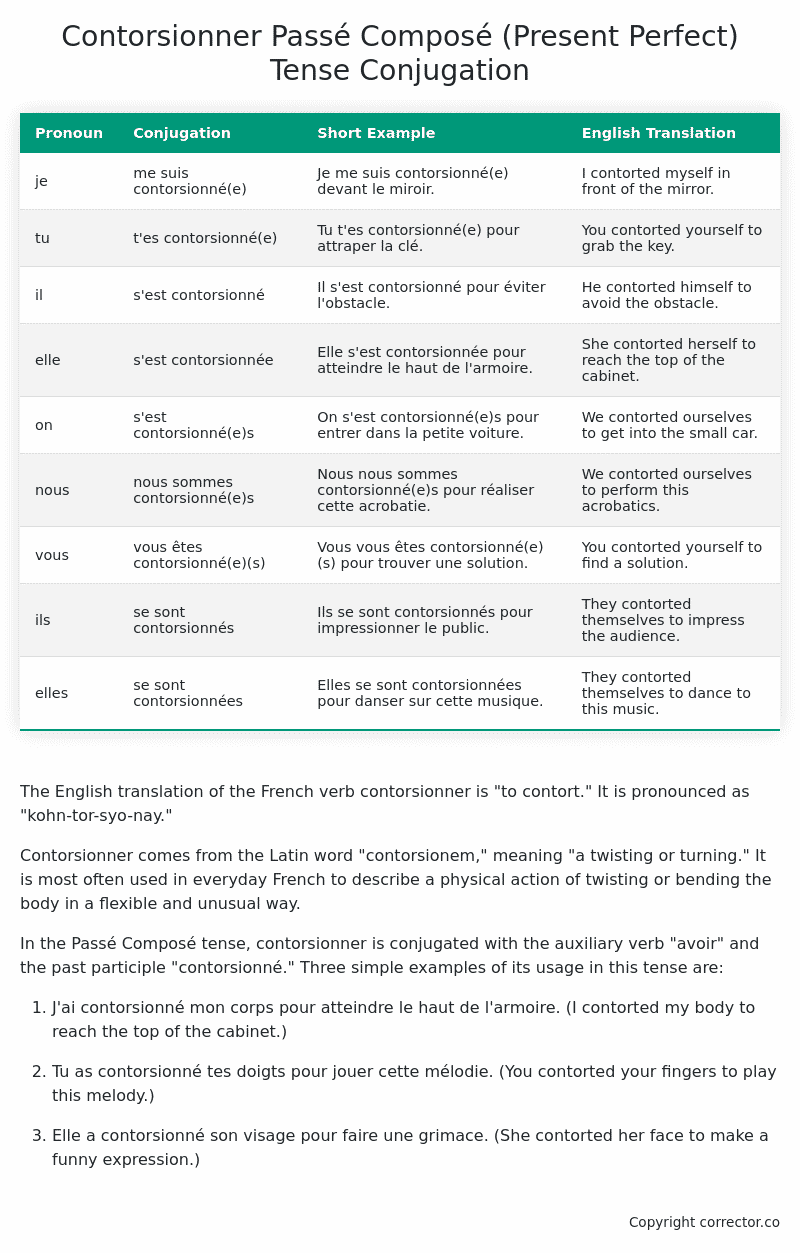Passé Composé (Present Perfect) Tense Conjugation of the French Verb contorsionner
Introduction to the verb contorsionner
The English translation of the French verb contorsionner is “to contort.” It is pronounced as “kohn-tor-syo-nay.”
Contorsionner comes from the Latin word “contorsionem,” meaning “a twisting or turning.” It is most often used in everyday French to describe a physical action of twisting or bending the body in a flexible and unusual way.
In the Passé Composé tense, contorsionner is conjugated with the auxiliary verb “avoir” and the past participle “contorsionné.” Three simple examples of its usage in this tense are:
-
J’ai contorsionné mon corps pour atteindre le haut de l’armoire. (I contorted my body to reach the top of the cabinet.)
-
Tu as contorsionné tes doigts pour jouer cette mélodie. (You contorted your fingers to play this melody.)
-
Elle a contorsionné son visage pour faire une grimace. (She contorted her face to make a funny expression.)
Table of the Passé Composé (Present Perfect) Tense Conjugation of contorsionner
| Pronoun | Conjugation | Short Example | English Translation |
|---|---|---|---|
| je | me suis contorsionné(e) | Je me suis contorsionné(e) devant le miroir. | I contorted myself in front of the mirror. |
| tu | t’es contorsionné(e) | Tu t’es contorsionné(e) pour attraper la clé. | You contorted yourself to grab the key. |
| il | s’est contorsionné | Il s’est contorsionné pour éviter l’obstacle. | He contorted himself to avoid the obstacle. |
| elle | s’est contorsionnée | Elle s’est contorsionnée pour atteindre le haut de l’armoire. | She contorted herself to reach the top of the cabinet. |
| on | s’est contorsionné(e)s | On s’est contorsionné(e)s pour entrer dans la petite voiture. | We contorted ourselves to get into the small car. |
| nous | nous sommes contorsionné(e)s | Nous nous sommes contorsionné(e)s pour réaliser cette acrobatie. | We contorted ourselves to perform this acrobatics. |
| vous | vous êtes contorsionné(e)(s) | Vous vous êtes contorsionné(e)(s) pour trouver une solution. | You contorted yourself to find a solution. |
| ils | se sont contorsionnés | Ils se sont contorsionnés pour impressionner le public. | They contorted themselves to impress the audience. |
| elles | se sont contorsionnées | Elles se sont contorsionnées pour danser sur cette musique. | They contorted themselves to dance to this music. |
Other Conjugations for Contorsionner.
Le Present (Present Tense) Conjugation of the French Verb contorsionner
Imparfait (Imperfect) Tense Conjugation of the French Verb contorsionner
Passé Simple (Simple Past) Tense Conjugation of the French Verb contorsionner
Passé Composé (Present Perfect) Tense Conjugation of the French Verb contorsionner (this article)
Futur Simple (Simple Future) Tense Conjugation of the French Verb contorsionner
Futur Proche (Near Future) Tense Conjugation of the French Verb contorsionner
Plus-que-parfait (Pluperfect) Tense Conjugation of the French Verb contorsionner
Passé Antérieur (Past Anterior) Tense Conjugation of the French Verb contorsionner
Futur Antérieur (Future Anterior) Tense Conjugation of the French Verb contorsionner
Subjonctif Présent (Subjunctive Present) Tense Conjugation of the French Verb contorsionner
Subjonctif Passé (Subjunctive Past) Tense Conjugation of the French Verb contorsionner
Subjonctif Imparfait (Subjunctive Imperfect) Tense Conjugation of the French Verb contorsionner
Conditionnel Présent (Conditional Present) Tense Conjugation of the French Verb contorsionner
Conditionnel Passé (Conditional Past) Tense Conjugation of the French Verb contorsionner
L’impératif Présent (Imperative Present) Tense Conjugation of the French Verb contorsionner
L’infinitif Présent (Infinitive Present) Tense Conjugation of the French Verb contorsionner
Struggling with French verbs or the language in general? Why not use our free French Grammar Checker – no registration required!
Get a FREE Download Study Sheet of this Conjugation 🔥
Simply right click the image below, click “save image” and get your free reference for the contorsionner present perfect tense conjugation!

Contorsionner – About the French Passé Composé (Present Perfect) Tense
Formation of the Passé Composé
Set the auxiliary verb with either
Conjugate the auxiliary verb
Add the past participle
Common everyday usage patterns
Narrating Past Events
Sequential Actions
Describing Completed Actions
Interactions with other tenses
Imperfect Tense
Conditional and Future Tenses
Summary
I hope you enjoyed this article on the verb contorsionner. Still in a learning mood? Check out another TOTALLY random French verb conjugation!


